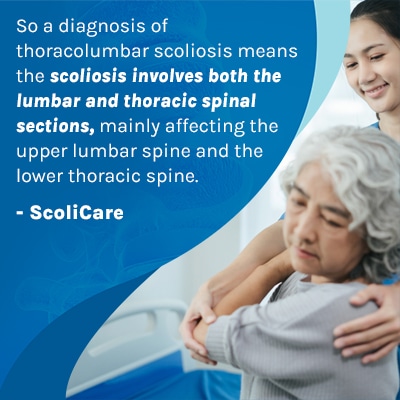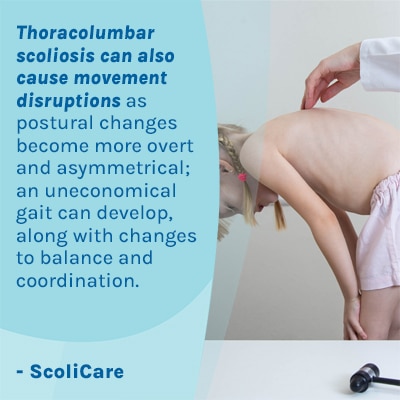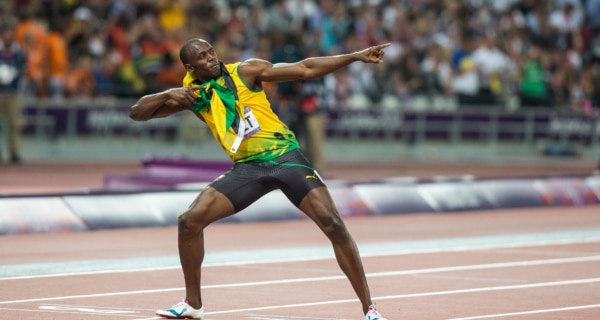No two cases of scoliosis are the same, which is why it’s crucial that treatment plans are individualized. The process of diagnosing scoliosis involves comprehensive assessment and classification based on a number of variables, one of which is curvature type and location.
A diagnosis of thoracolumbar scoliosis means a single progressive unnatural lateral spinal curve has developed that affects the thoracic spine and the lumbar spine. In these cases, the curve’s apex is at the thoracolumbar junction, where the two spinal sections meet.
Let’s discuss what it means to be diagnosed with thoracolumbar scoliosis, including common symptoms and treatment options.
Diagnosing Thoracolumbar Scoliosis
It’s not always easy to diagnose scoliosis. Although it affects all ages, it’s most commonly diagnosed during adolescence as Adolescent Idiopathic Scoliosis (1).
The adolescent age group includes patients between the ages of 10 and 18, and the idiopathic designation means cause unknown.
The vast majority of scoliosis cases are idiopathic, but that doesn’t mean we can’t treat them effectively, and part of potential treatment efficacy involves a comprehensive initial assessment and diagnosis.
To diagnose scoliosis, a patient’s family history is considered, postural assessment is performed, and a physical examination is performed including an Adam’s forward bend test; this is a common screening exam that looks for indicators of scoliosis.
If the spine’s unnatural bend is noticeable in this position, and/or trunk asymmetries are present, a scoliosis X-ray may be deemed appropriate and ordered to confirm the spine’s curve size, rotational component, and to assess bone age in younger patients (1).
A true scoliosis doesn’t just involve an unnatural bend in the spine, but also rotation, and determining the size of the scoliosis is a key factor that treatment plans are customized around; another key factor that needs to be assessed is curvature type and location.
S-Shaped Scoliosis
The spine has three main sections including the cervical spine (neck), thoracic spine (middle/upper back), and the lumbar spine (lower back) (1).
 In many cases, only one curve exists, and this can look like a ‘C-shape’. In a single thoracolumbar curve, where the curve is most severe at the junction of the thoracic and lumbar regions of the spine, the curve can have a ‘C-shape’. If a secondary curve develops after the primary thoracolumbar curve, this may look like an ‘S-shape’.
In many cases, only one curve exists, and this can look like a ‘C-shape’. In a single thoracolumbar curve, where the curve is most severe at the junction of the thoracic and lumbar regions of the spine, the curve can have a ‘C-shape’. If a secondary curve develops after the primary thoracolumbar curve, this may look like an ‘S-shape’.
A thoracolumbar curve is a common type, particularly when it comes to Adolescent Idiopathic Scoliosis.
So what causes this type of scoliosis to develop.
Thoracolumbar Scoliosis Causes
As mentioned, most cases of scoliosis don’t have a clear single-known cause; in fact, approximately 80 percent of cases are idiopathic (2).
Although idiopathic scoliosis has no single- known cause, it’s thought to have multiple causes (multifactorial).
Conditions that are multifactorial can be caused by a number of factors, or a combination of factors, that vary from patient to patient.
These cases of scoliosis are typical, but there are also cases that are associated with known causes and are considered atypical with different symptoms and treatment needs; this includes neuromuscular scoliosis (2), degenerative scoliosis (3), and congenital scoliosis (2).
Neuromuscular scoliosis is caused by a neuromuscular condition interrupting communication between the brain, spine, and muscles/connective tissues that provide the spine with support and stability, so treatment has to focus on the larger medical condition causing the scoliosis.
Degenerative de novo scoliosis is caused by the spine becoming increasingly unstable due to degenerative changes, most of which start with the spine’s intervertebral discs (3).
Congenital scoliosis is caused by the spine not forming properly in utero; babies are born with this type of scoliosis.
Pelvic obliquity is also associated with the development of thoracolumbar scoliosis; an unnaturally-tilted pelvis can cause a leg length discrepancy that disrupts posture, and the asymmetry can contribute to the development of a compensatory scoliosis in the lumbar and/or thoracolumbar spine.
Thoracolumbar Scoliosis Symptoms
Thoracolumbar scoliosis symptoms will vary from person to person based on curve size, degree of vertebral rotation, and patient age.
Although we don’t know what causes most cases of scoliosis to develop initially, we know it’s growth that makes it progress, so the more growth a patient has to go through prior to reaching skeletal maturity, the more potential progression there may be (1).
Common symptoms include postural changes such as uneven shoulders, shoulder blades, hips, and as the thoracic spine is the only spinal section attached to the rib cage, one side of the rib cage protruding more than the other side is also common (rib cage arch) and pain.
As the spine is key to the body’s structure and alignment, if it becomes misaligned, the effects aren’t just isolated to the spine and can disrupt the body’s overall symmetry and appearance from the head to the feet.
While compressive pain isn’t commonly associated with childhood scoliosis, pain can also be caused by the asymmetry and related muscle pain, disc issues, and nerve impingement (1).
Thoracolumbar scoliosis can also cause movement changes as postural changes become more overt and asymmetrical; an uneconomical gait can develop, along with changes to balance and coordination.
As a progressive condition, it’s the nature of scoliosis symptoms to become more noticeable over time, but while there are no treatment guarantees, scoliosis can be highly treatable, especially with an early diagnosis and proactive treatment plan (2, 4).
Thoracolumbar Scoliosis Treatment
When it comes to quality of life and scoliosis symptoms, the best way to minimize the potential effects of an unnatural sideways bend and twist in the spine is to address their cause: the spine’s structural misalignment.
There are different ways to address scoliosis, and patients have two main choices: traditional treatment and potential spinal fusion surgery, or nonsurgical treatment options.
The nonsurgical treatment process is based on customization and the integration of corrective bracing and scoliosis-specific exercise-based treatment (4, 5,).
When it comes to addressing scoliosis, the first step is determining if more than one curve exists. If so, usually the larger curve will be classified as the primary curve. Both curves are addressed, but the primary curve is usually the main focus in order to minimize the risk of surgery.
Nonsurgical treatment is proactive; it’s started immediately following a diagnosis because as a progressive condition, the best time to start treatment is always now.
A diagnosis of mild scoliosis doesn’t mean the scoliosis will stay mild, and mild doesn’t mean minor or that there is more time to consider different treatment options; scoliosis is simplest to treat the milder it is, so this is precisely the time to start addressing scoliosis.
The potential benefits of early detection are only available to patients whose treatment has a proactive approach.
While there are no treatment guarantees, particularly in children who are still growing, diagnosing scoliosis and starting treatment early is directly associated with treatment success, and the potential success of corrective bracing and exercise-based treatment programs is proven and evidence-based (4, 5, 6, 7, 8).
Corrective Bracing: ScoliBrace®

With growing spines, it’s easier to improve the position of the spine with bracing, and ScoliCare patients benefit from accessing the world’s most-advanced scoliosis brace: the ScoliBrace® (4, 5, 6).
The ScoliBrace® represents the culmination of what Clinicians have observed and learned about scoliosis and bracing efficacy over the years.
Each brace is custom-designed to address the specifics of a patient’s posture, body type, and curve type, and the goal of the brace is to improve the spine’s alignment and body posture.
The ScoliBrace® was designed with movement in mind, which is different from traditional bracing based on immobilizing the spine, and this helps to maintain the spine’s flexibility, making it more responsive to treatment, and improving trunk muscle endurance (4).
A healthy spine needs strong and balanced surrounding muscles for support and stability.
The over-corrective approach of the brace uses spinal coupling to create a better position for the spine and 3D postural correction.
While the brace holds the spine in an over-corrective position, this can also help stimulate communication between the brain, the spine, muscles and joints that all work together to maintain a healthy body position and posture.
And because the brace is designed with movement in mind, it can be combined with a powerful exercise-based program to further 3D results.
Exercise-Based Treatment: ScoliBalance®
ScoliBalance® is a physiotherapeutic scoliosis-specific exercise program for addressing scoliosis in patients of all ages, and the goal is to restore the spine and body’s alignment (4).
The ScoliBalance® program is multifaceted, combining the best of chiropractic care, physical therapy and exercise rehabilitation for a 3D approach to improving scoliosis.
Exercise programs are tailored to each individual patient for specific results, and the program is aligned with SOSORT (Society on Scoliosis Orthopaedic and Rehabilitation Treatment) guidelines (8).
As patients are taught 3D postural correction through awareness of how to hold their spines and bodies during movement, this can facilitate postural restoration and sustainable treatment results.
Once patients are confident and capable, they can perform the exercises from home to further stabilize the spine and apply postural awareness to daily activities.
ScoliBalance® is a powerful program that may slow/stop curve progression, improve spinal flexibility, core muscle strength, the spine’s balance, alignment, stability, posture, and body appearance (2, 4).
In older patients with degenerative de novo scoliosis, improvements to stability are key to minimize the risk of injury through a fall (3).
Conclusion
Thoracolumbar scoliosis is a common single curve type that indicates an unnatural bend and twist in the spine has developed affecting two spinal sections as an S-shaped curve: the upper lumbar spine and the lower thoracic spine.
In most cases, the cause is unknown, and in atypical cases, causes can be neuromuscular, degenerative, or congenital.
A patient’s scoliosis symptoms are shaped by a number of factors including patient age, condition severity, type, curve type and location, but commonly include pain (adult scoliosis), postural changes including uneven hips, shoulders, the development of an arch in the rib cage, and disruptions to gait, balance, and coordination.
When it comes to scoliosis solutions, no treatment results can be guaranteed, but the potential results of combining the ultra-corrective ScoliBrace® with a customized ScoliBalance® program is a spine and body that’s stronger, more flexible, stable, and balanced.
References:
- Weinstein SL. The Natural History of Adolescent Idiopathic Scoliosis. J Pediatr Orthop. 2019 Jul;39(Issue 6, Supplement 1 Suppl 1):S44-S46. doi: 10.1097/BPO.0000000000001350. PMID: 31169647.
- Konieczny MR, Senyurt H, Krauspe R. Epidemiology of adolescent idiopathic scoliosis. Journal of Children’s Orthopaedics. 2013;7(1):3-9. doi:10.1007/s11832-012-0457-4
- Marty-Poumarat, Catherine MD*; Scattin, Luciana MD†; Marpeau, Michèle MD*; Garreau de Loubresse, Christian MD‡; Aegerter, Philippe MD, PhD§. Natural History of Progressive Adult Scoliosis. Spine 32(11):p 1227-1234, May 15, 2007. | DOI: 10.1097/01.brs.0000263328.89135.a6
- Marchese R, Du Plessis J, Pooke T, McAviney J. The Improvement of Trunk Muscle Endurance in Adolescents with Idiopathic Scoliosis Treated with ScoliBrace® and the ScoliBalance® Exercise Approach. J Clin Med. 2024 Jan 23;13(3):653. doi: 10.3390/jcm13030653. PMID: 38337346; PMCID: PMC10856658.
- Lim KBL, Mak HKW, Abdul Rahaman SH, Ong LL, Ooi SYJ, Lee NKL. A pilot study on the “ScoliBrace” in the treatment of adolescent idiopathic scoliosis. Eur J Orthop Surg Traumatol. 2024 May;34(4):1803-1809. doi: 10.1007/s00590-024-03845-6. Epub 2024 Feb 28. PMID: 38416233.
- Nalda A, Mirenzi R, Doueihi NL, McAviney J. A Non-Surgical Multimodal Approach to Severe Thoracic Adolescent Idiopathic Scoliosis Combining ScoliBrace and Scoliosis-Specific Rehabilitation Therapies: A Case Series. Healthcare (Basel). 2025 Jun 26;13(13):1522. doi: 10.3390/healthcare13131522. PMID: 40648546; PMCID: PMC12249254.
- Liu D, Yang Y, Yu X, Yang J, Xuan X, Yang J, Huang Z. Effects of Specific Exercise Therapy on Adolescent Patients With Idiopathic Scoliosis: A Prospective Controlled Cohort Study. Spine (Phila Pa 1976). 2020 Aug 1;45(15):1039-1046. doi: 10.1097/BRS.0000000000003451. PMID: 32675606; PMCID: PMC7373466
- Negrini S, Donzelli S, Aulisa AG, Czaprowski D, Schreiber S, de Mauroy JC, Diers H, Grivas TB, Knott P, Kotwicki T, Lebel A, Marti C, Maruyama T, O’Brien J, Price N, Parent E, Rigo M, Romano M, Stikeleather L, Wynne J, Zaina F. 2016 SOSORT guidelines: orthopaedic and rehabilitation treatment of idiopathic scoliosis during growth. Scoliosis Spinal Disord. 2018 Jan 10;13:3. doi: 10.1186/s13013-017-0145-8. PMID: 29435499; PMCID: PMC5795289


